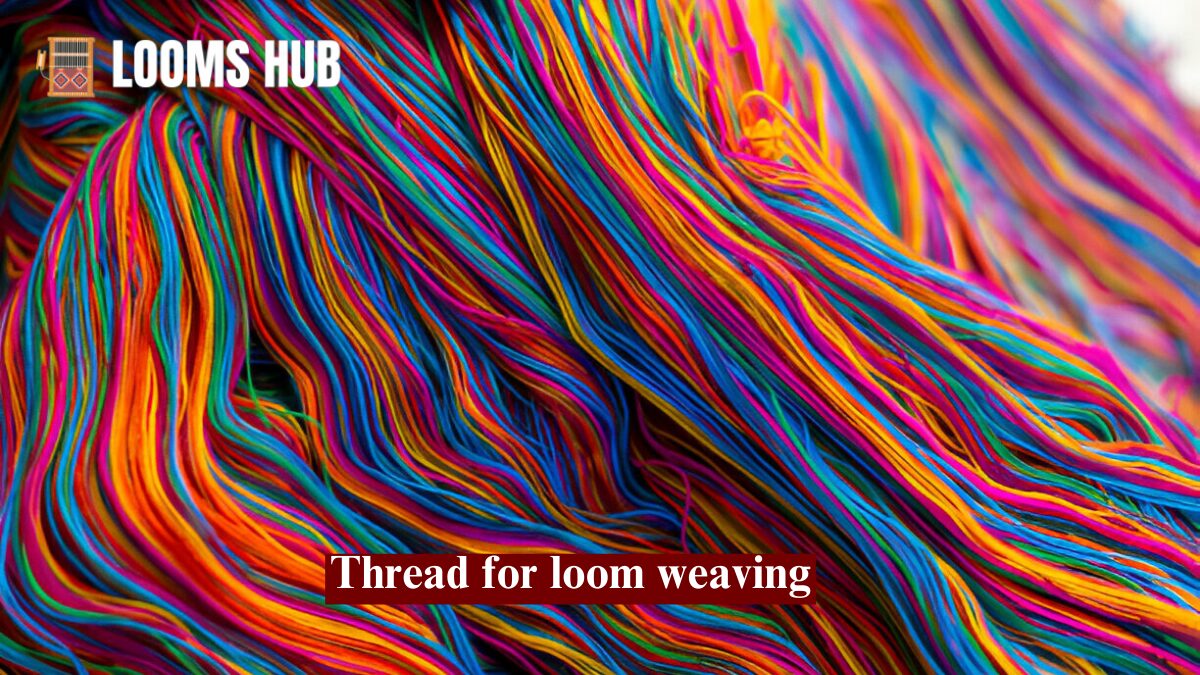Loom weaving is an ancient and intricate craft that combines skill, creativity, and precision. In this world, the thread you choose can make or break your project. Whether you’re creating delicate scarves, durable rugs, or intricate tapestries, understanding the characteristics of different types of threads and how to select the right one for each project is crucial.
At the heart of loom weaving are two types of threads: warp and weft. These threads work together to create the structure and beauty of your fabric. However, selecting the right thread goes beyond understanding warp vs. weft it’s about choosing the right material, weight, and texture to achieve the desired results.
This guide will take you through every aspect of loom weaving threads, from the types of fibers available to tips on how to use them effectively. By the end, you’ll be well-equipped to make informed decisions about the thread that suits your weaving projects best.
Understanding Loom Weaving Threads: Warp vs. Weft
What Are Warp Threads?
In loom weaving, warp threads are the foundation of your fabric. These threads are set up on the loom in a parallel arrangement, usually under tension, and form the lengthwise structure of your woven piece. The warp must be strong enough to withstand the tension applied during weaving, and it plays a critical role in the stability and overall durability of the fabric.
Characteristics of Warp Threads:
- Durability: The warp needs to resist tension over an extended period, so durability is crucial.
- Strength: It must be able to support the shuttle’s movement and any weight added during the weaving process.
- Material: Common materials for warp threads include cotton, linen, and synthetic fibers, each with specific benefits.
For example, cotton is often used for warp threads in lightweight fabrics, while linen is chosen for heavier, more durable fabrics like upholstery. The strength of the warp is directly proportional to the overall strength and longevity of the fabric.
What Are Weft Threads?
The weft threads run perpendicular to the warp threads and are woven across them to create the fabric’s texture. These threads provide the color, texture, and pattern of the fabric and are typically thicker or softer than the warp threads. Weft threads are integral to the design and visual appeal of the finished textile.
Characteristics of Weft Threads:
- Texture and Appearance: Weft threads create the design, color, and texture of the woven fabric.
- Material: These threads can be made from cotton, wool, silk, or any number of yarns that add visual interest.
- Variety: Weft threads can be mixed and matched to create different textures, colors, and patterns.
The weft is more about the tactile experience of the finished textile—whether it’s a plush wool blanket or a smooth silk scarf. The choice of weft thread determines the feel and finish of the fabric.
Types of Threads for Loom Weaving: Materials and Characteristics
Choosing the right type of thread is a key decision in any loom-weaving project. Each material has unique qualities that can affect the texture, appearance, and function of the fabric. Here’s an in-depth look at the most popular thread materials used in loom weaving.
Cotton Threads: Soft and Versatile
Cotton is one of the most popular materials used in loom weaving. It’s known for its soft texture, ease of use, and availability in a wide range of weights and colors. Cotton threads are great for both beginners and advanced weavers, as they are easy to work with and create durable, breathable fabrics.
Uses of Cotton Thread:
- Towels and Dishcloths: Cotton is highly absorbent, making it perfect for kitchen textiles.
- Scarves and Garments: Cotton is breathable, soft, and ideal for lightweight clothing.
- Home Decor: Cotton’s texture works well for placemats, table runners, and other decorative items.
Characteristics of Cotton Thread:
- Breathable and Absorbent: Cotton absorbs moisture efficiently, which is why it’s a popular choice for towels and bedding.
- Easy to Dye: Cotton fibers absorb dye beautifully, so you can create vibrant and long-lasting colors.
- Soft and Comfortable: Cotton is gentle on the skin, making it perfect for garments like scarves or t-shirts.
Cotton’s versatility makes it suitable for a variety of projects, from everyday items to specialty fabrics. Its ability to hold color also allows weavers to experiment with different patterns and shades.
Wool Threads: Warmth and Texture
Wool is another fantastic choice for loom weaving. It’s warm, and resilient, and adds a rich texture to woven fabrics. Wool threads are often used in projects that require comfort and insulation, such as blankets, throws, and sweaters.
Uses of Wool Thread:
- Scarves, Blankets, and Sweaters: Wool provides warmth and softness, making it a go-to for winter wear.
- Tapestries: The texture of wool makes it ideal for artistic woven works, adding dimension to tapestries and wall hangings.
- Felted Projects: Wool is also used in felting, adding another layer of creativity to loom weaving.
Characteristics of Wool Thread:
- Elastic and Stretchable: Wool is a naturally stretchy material, giving it more flexibility during the weaving process.
- Insulating: Wool traps air within its fibers, making it a great material for cold-weather textiles.
- Moisture-Wicking: Wool helps wick away moisture from the body, keeping wearers comfortable in varying temperatures.
Wool’s elasticity and insulating properties make it perfect for heavier, warm textiles. Wool can also create luxurious finishes for garments and home décor pieces.
Silk Threads: Luxurious and Smooth
Silk is one of the most luxurious materials for weaving, providing a smooth, shiny finish. Its sheen, soft feel, and strong fibers make it an excellent choice for high-end textiles such as fine clothing, scarves, and decorative fabric pieces.
Uses of Silk Thread:
- Luxury Scarves and Shawls: Silk threads are often used in the creation of high-end scarves, shawls, and other fashion items.
- Tapestries and Wall Hangings: The reflective quality of silk adds a beautiful, shimmering effect to woven art pieces.
- Fine Garments: Silk’s smooth texture and strength make it a popular choice for creating soft and durable fine garments.
Characteristics of Silk Thread:
- Shiny and Smooth: Silk’s natural sheen and smooth texture give woven fabrics an elegant and luxurious finish.
- Delicate Handling: While silk is strong, it can be slippery and requires careful handling when weaving.
- Strong and Durable: Silk is stronger than it appears, providing both beauty and strength in woven pieces.
Silk threads are ideal for projects that require a high degree of elegance and sophistication. Its unique texture can transform any woven fabric into a beautiful work of art.
Linen Threads: Durable and Crisp
Linen is made from the flax plant and is known for its strength, durability, and crisp texture. It is often used in traditional weaving, especially for textiles that need to withstand repeated use, like upholstery and table linens.
Uses of Linen Thread:
- Table Linens and Upholstery: Linen’s durability makes it ideal for textiles that are exposed to frequent wear.
- Rugs and Floor Coverings: Linen’s strength and resistance to wear make it perfect for creating woven rugs.
- Rustic Clothing: Linen is commonly used for creating rustic-style shirts, dresses, and other garments.
Characteristics of Linen Thread:
- Strong and Durable: Linen fibers are among the strongest natural fibers, making them ideal for heavy-duty fabrics.
- Crisp Texture: Linen’s crisp texture gives woven pieces a natural, rustic feel.
- Softens with Use: While linen can be stiff initially, it softens over time, becoming more flexible and comfortable with use.
Linen’s durability and rustic charm make it the perfect choice for sturdy, long-lasting woven textiles. Over time, linen becomes softer and more pliable, adding to its appeal.
Synthetic Threads: Strength and Durability
Synthetic threads, including materials like polyester, nylon, and acrylic, have gained popularity in loom weaving due to their durability, resistance to stretching, and low-maintenance nature. These threads are often used for creating industrial-strength fabrics and textiles designed for heavy use.
Uses of Synthetic Threads:
- Heavy-Duty Upholstery and Rugs: Synthetic threads are commonly used in commercial weaving for durable products like carpets and upholstery.
- Outdoor Textiles: Synthetic fibers are ideal for items exposed to the elements, such as outdoor cushions, tarps, and tents.
- Workwear and Utility Fabrics: Synthetic threads are often used in fabrics that need to withstand wear and tear, such as uniforms and workwear.
Characteristics of Synthetic Threads:
- Elastic and Strong: Synthetic fibers are designed to be strong and resistant to wear, making them perfect for heavy-duty applications.
- Low Maintenance: These threads are resistant to fading, shrinking, and stretching, offering durability and convenience.
- Lack of Natural Texture: While synthetic threads may not have the same tactile qualities as natural fibers, they can be engineered to mimic them.
Synthetic threads are ideal for creating functional, long-lasting fabrics that need to stand up to heavy use and environmental factors. Their strength and ease of care make them popular in industrial and outdoor applications.
How to Choose the Right Thread for Your Loom Weaving Project
Selecting the right thread depends on several key factors, including the intended use of the fabric, the type of texture and appearance you’re aiming for, and your room type. Here’s how to approach the decision:
Consider the Type of Project
- Durability Needs: For textiles that will see regular use, such as towels, dishcloths, or upholstery, opt for durable threads like cotton, linen, or synthetic fibers.
- Comfort and Softness: For garments, scarves, and other clothing items, consider wool or silk, as these threads provide softness and warmth.
- Texture and Visual Appeal: If texture is important, wool and linen threads offer a more textured finish. Silk, on the other hand, adds a smooth and shiny aesthetic.
Determine the Weight of the Thread
The weight of the thread significantly impacts the feel and structure of the finished fabric. Lighter threads, like cotton, are ideal for delicate, lightweight fabrics, while heavier threads like wool or linen are better for thicker, more substantial materials.
- Lightweight Threads: Great for creating delicate fabrics with a soft drape and breathable texture.
- Heavyweight Threads: Perfect for sturdy fabrics that require more structure, such as upholstery or rugs.
Consider the Dyeing Potential
The ability to dye your threads is important if you want vibrant, long-lasting colors in your fabric. Natural fibers like cotton, wool, and silk accept dye well, creating rich, beautiful hues. Synthetic fibers can also be dyed, though the process may vary and require special attention.
Think About the Loom Type
Different looms have varying requirements when it comes to the thread you use. Rigid heddle looms, for instance, are best suited to finer threads, while a floor loom can accommodate thicker threads for heavier projects.
Tips for Working with Loom Weaving Threads
Once you’ve chosen the right thread for your project, consider these tips to make the weaving process as smooth as possible:
1. Pre-Wash Your Thread
For natural fibers, pre-washing helps to remove any excess dye and prepare the threads for weaving. This also helps prevent shrinkage after the fabric is completed.
2. Maintain Consistent Tension
Ensuring that your warp threads are evenly tensioned is essential for achieving an even weave. Uneven tension can lead to distortion, so it’s important to check regularly.
3. Organize Your Threads
Organize your threads to avoid tangling or mixing up different colors and materials. Use spools, bobbins, or thread holders to keep everything neat and accessible.
4. Experiment and Practice
If you’re new to loom weaving, practice with different materials and techniques to better understand how various threads behave. Experimenting will help you improve your skills and develop a personal weaving style.
FAQs
1. What type of thread is best for loom weaving?
- Cotton: Ideal for durability and ease of use.
- Wool: Great for traditional weaving and creating texture.
- Linen: Known for its strength and smooth finish.
- Silk & Synthetic Threads: Best for finer, decorative designs.
2. Can I use any thread for loom weaving?
- Not all threads are suitable for loom weaving. Choose a thread that:
- Is strong enough to withstand tension.
- Is flexible to weave through the loom.
- Matches the project’s desired outcome.
3. What is the difference between warp and weft threads?
- Warp Threads:
- Vertical threads on the loom, bear tension.
- Should be stronger and more durable.
- Weft Threads:
- Horizontal threads are woven through the warp.
- Can vary in thickness and texture for different effects.
4. How do I choose the right thickness of thread for loom weaving?
- Thicker Threads: Create more texture and heavier fabrics.
- Thinner Threads: Perfect for delicate designs and intricate patterns.
- Match thread thickness to the loom’s capacity and the fabric type.
5. Can I use embroidery thread for loom weaving?
- Yes, embroidery thread can be used, but:
- It’s thinner than standard weaving threads, so multiple strands may be needed.
- Suitable for smaller, finer projects like tapestries or detailed cloth.
6. How do I prepare a thread for loom weaving?
- Warp Threads: Securely tie them onto the loom and evenly space them.
- Weft Threads: Wind onto a shuttle or bobbin to avoid tangles.
- Separate different thread types or colors to keep organized.
7. What thread colors should I choose for loom weaving?
- Light Colors: Create subtle, muted designs.
- Dark or Vibrant Colors: Stand out and create bold patterns.
- Gradient or Variegated Threads: Add texture and depth to the fabric.
8. How do I fix broken threads while loom weaving?
- Warp Threads: Tie broken ends securely with a knot.
- Weft Threads: Restart by cutting a new thread and weaving it from the breakpoint.
- Ensure knots are tight and seamless to avoid visible damage.
9. What thread is best for tapestry weaving?
- Wool Threads: Highly recommended for their texture and richness.
- Other Options: Cotton, silk, or metallic threads for varied and intricate designs.
10. Can I use synthetic thread for loom weaving?
- Yes, synthetic threads like nylon or polyester can be used:
- More durable and less prone to fraying.
- May lack the tactile qualities of natural fibers but are great for strong, long-lasting projects.
Conclusion
Choosing the right thread for your loom weaving project is a crucial decision that influences the look, feel, and durability of your fabric. By understanding the characteristics of different fibers whether cotton, wool, silk, linen, or synthetic you can elevate your weaving projects to new heights.
The type of thread you select should match both the functional and aesthetic needs of your project. Whether you’re creating cozy garments, intricate tapestries, or sturdy home textiles, the right thread ensures that your finished piece will be as beautiful as it is functional.



